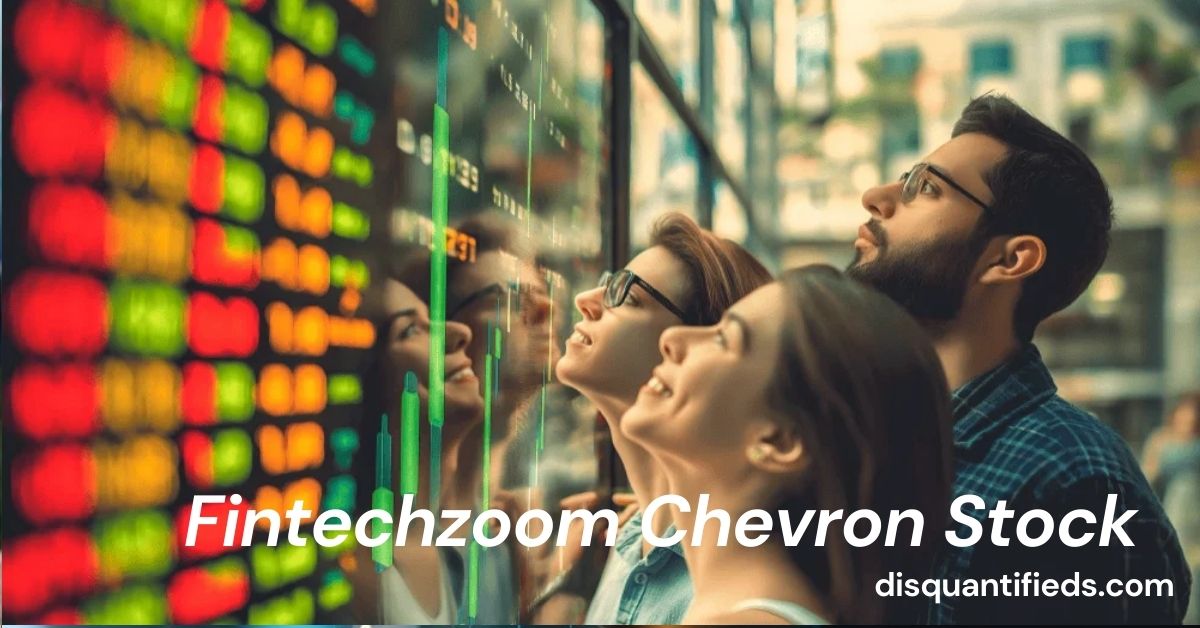Fintechzoom Chevron Stock: A Detailed Analysis of Performance, Ownership, and Future Trends
Chevron Corporation, a giant in the oil and gas industry, has long been a favorite among investors. Known for its stability, extensive operations, and consistent dividends, Chevron stock remains a crucial player in the investment landscape. But how does the stock perform in the ever-changing market? What are the key metrics and trends that shape its future? In this comprehensive article, we’ll explore all the details surrounding Fintechzoom Chevron stock, its performance, key metrics, ownership details, and the future trends that investors need to watch closely. Our goal is to provide insights that go beyond what is typically available to offer an in-depth understanding of this significant stock.
What Is Fintechzoom Chevron Stock?
Fintechzoom Chevron stock refers to the stock of Chevron Corporation, analyzed and reported on the Fintechzoom platform. Fintechzoom is a financial news outlet known for providing real-time data and analysis on stocks, market trends, and economic shifts. By providing a focused view on companies like Chevron, Fintechzoom offers investors a reliable source of information to assess the potential and performance of individual stocks.
Chevron, an American multinational corporation, has a stronghold in the global energy market. With operations that span across exploration, extraction, refining, and distribution of oil and natural gas, Chevron plays a critical role in the worldwide energy supply. As such, its stock is widely traded and considered a benchmark in the energy sector. Investors look at Fintechzoom Chevron stock as an opportunity to track not just Chevron’s own performance but also the broader movements in the energy market.

The Current State of Chevron’s Stock Performance
To truly understand Fintechzoom Chevron stock, it’s important to first break down how the stock is performing. There are various key metrics, indicators, and historical trends that can help assess whether Chevron stock is a good investment.
Key Metrics of Chevron’s Stock
- Price-to-Earnings (P/E) Ratio
The P/E ratio is an essential metric for investors. It compares a company’s stock price to its earnings per share (EPS). A higher P/E ratio can often signal that investors have high expectations for a company’s future earnings, while a lower ratio might suggest undervaluation. As of the most recent figures, Chevron stock has a P/E ratio that is competitive within the energy sector, signaling confidence from investors in its ability to generate sustainable profits. A higher P/E can be expected due to Chevron’s market dominance and its potential for growth as global energy demand rises.
- Dividends
Chevron is known for offering one of the most reliable and robust dividend yields among oil and gas companies. The company pays quarterly dividends, which appeal to income-focused investors. Even during periods of economic uncertainty or oil price volatility, Chevron has managed to maintain its dividend payouts, reinforcing its stability as a dividend stock. For investors who seek a combination of capital appreciation and income, Fintechzoom Chevron stock provides an attractive option.
Also Read: 3822 Blossom Terrace Erie PA Water Cut Opffs: Understanding the Impact, Causes, and Solutions
- Earnings Growth
Chevron’s earnings growth has fluctuated in recent years, mainly due to shifts in oil prices. When oil prices are high, Chevron tends to see significant growth in its earnings. However, when prices drop, such as during the 2020 oil price crash, the company’s earnings may dip. Despite these fluctuations, Chevron has consistently demonstrated resilience through strategic diversification, cost management, and technological advancements. Over the last few years, Chevron has worked to reduce production costs and increase efficiency, thus improving its ability to adapt to changes in the market.
Stock Price History
Chevron’s stock price history is closely tied to the price of crude oil. Historically, as oil prices climb, so too does Fintechzoom Chevron stock. The reverse is also true. The price of oil is affected by a multitude of factors, such as geopolitical tensions, OPEC production cuts, and demand shifts due to economic growth or downturns.
For instance, in the early 2020s, when the world was impacted by the COVID-19 pandemic, global oil demand decreased drastically, causing oil prices to plummet. During this period, Chevron stock also suffered, though it showed resilience compared to other oil companies due to its strong balance sheet and diversified operations. Following the recovery of global economies, Chevron’s stock has been able to bounce back, although market fluctuations remain a constant risk.
Ownership and Institutional Investors in Chevron
Chevron’s stock is held by a diverse group of institutional investors, individual shareholders, and insiders. The distribution of ownership plays a significant role in understanding the company’s stock movements.
Largest Institutional Shareholders
Some of the largest institutional shareholders of Fintechzoom Chevron stock include major asset management firms and mutual funds. These include:
Also Read: How to Get the Perfect Light Brown Nails Color Backstageviral.com
- Vanguard Group: Vanguard is one of the largest investment management companies globally, holding a significant portion of Chevron’s stock. Vanguard’s stake in Chevron represents confidence in the company’s long-term growth prospects.
- BlackRock: Another major institutional investor, BlackRock manages trillions of dollars in assets and holds a large share of Chevron stock, further solidifying Chevron’s position as a dominant player in the energy sector.
- State Street Global Advisors: As one of the largest institutional asset managers, State Street is also a major shareholder in Chevron. These institutional investors play a crucial role in maintaining the stability and liquidity of Fintechzoom Chevron stock.
Insider Ownership
In addition to institutional investors, Chevron insiders, including executives and board members, hold shares in the company. This alignment of interests ensures that Chevron’s leadership is motivated to increase shareholder value, as their personal wealth is tied to the company’s stock performance. Insider ownership can be an important indicator for investors who want to assess the level of confidence Chevron’s leadership has in the company’s future.
Analyzing Future Trends for Chevron Stock
The Impact of the Energy Transition
One of the most significant factors that will shape the future of Fintechzoom Chevron stock is the global energy transition. The world is shifting away from traditional fossil fuels toward renewable energy sources like solar, wind, and hydroelectric power. Governments, investors, and consumers are becoming increasingly concerned about climate change, prompting stricter regulations on the oil and gas industry.
Chevron has recognized these challenges and is actively investing in cleaner energy technologies. In addition to its oil and gas operations, Chevron is expanding into renewable energy through investments in carbon capture technologies, hydrogen fuel, and wind and solar energy projects. Chevron has committed billions of dollars to its low-carbon energy initiatives, positioning itself as an energy company that is actively working toward sustainability.
As global demand for oil is expected to plateau in the coming decades, Chevron’s pivot toward renewable energy sources will help stabilize its stock performance. This transition will also open up new markets and revenue streams for the company, ensuring long-term growth.
The Price of Oil
The price of oil will continue to be a major driver of Fintechzoom Chevron stock performance. The price of crude oil is influenced by factors such as:
- OPEC Decisions: The Organization of the Petroleum Exporting Countries (OPEC) plays a key role in regulating oil prices by adjusting production quotas. As OPEC decides to increase or decrease production, it directly impacts the supply and demand balance of crude oil, and by extension, the price of oil.
- Global Economic Health: The health of the global economy influences oil demand. In periods of economic growth, the demand for energy increases, which leads to higher oil prices and higher stock prices for companies like Chevron. Conversely, economic downturns can reduce oil demand, leading to lower oil prices and stock performance.
- Geopolitical Factors: Conflicts in oil-rich regions, such as the Middle East, can cause oil prices to spike due to concerns over supply disruptions. Chevron’s stock is often impacted by such geopolitical risks, which can lead to periods of volatility.
Regulatory Changes
As governments around the world implement more stringent regulations on emissions and environmental standards, Chevron stock may face additional pressures. Chevron’s response to these regulations will be crucial in determining its long-term success. The company’s ability to adapt to new environmental standards, invest in clean technologies, and reduce its carbon footprint will affect its stock price.
Also Read: Cursed-Memes.com Business: Turning Viral Chaos into Profit
Increased regulation could lead to higher operating costs for Chevron in the short term, but the company’s investment in green technologies may help mitigate these risks over time.
Investment Considerations: Is Chevron Stock a Good Buy?
Pros of Investing in Chevron
- Steady Dividend Payouts: Chevron’s strong dividend history makes it an appealing choice for income-focused investors. Even during times of economic uncertainty, Chevron has maintained its dividend payouts.
- Industry Leader: As one of the largest energy companies globally, Chevron is well-positioned to weather market fluctuations and continue generating revenue from both traditional oil and renewable energy sources.
- Diversification: Chevron’s efforts to diversify its operations into renewable energy help reduce its reliance on oil prices, potentially offering more stability to its stock performance in the future.
Cons of Investing in Chevron
- Oil Price Volatility: Chevron’s performance is highly correlated with the price of oil. Major fluctuations in oil prices, driven by factors like geopolitical events or changes in supply and demand, can result in significant volatility for the stock.
- Environmental Risks: Stricter environmental regulations and the global push for cleaner energy sources may pose challenges for Chevron in the coming years.
FAQs About Fintechzoom Chevron Stock
What is the best time to buy Chevron stock?
The best time to buy Fintechzoom Chevron stock depends on various factors, including the price of oil and market conditions. Ideally, it may be beneficial to buy during periods of low oil prices when the stock is undervalued, provided you are confident in the company’s long-term strategy.
How often does Chevron pay dividends?
Chevron pays quarterly dividends, which is a significant attraction for dividend investors. The company has a strong record of maintaining dividend payouts even during market downturns.
How can I monitor Chevron’s stock performance on Fintechzoom?
You can track Fintechzoom Chevron stock using Fintechzoom’s platform, which provides real-time data, stock charts, earnings reports, and other relevant information about Chevron’s performance.
Is Chevron a good long-term investment?
Chevron can be a good long-term investment for those interested in the energy sector. With a strong dividend yield, a diversified portfolio, and a push toward renewable energy, Chevron is well-positioned for growth over the next decade.
What risks should I be aware of before investing in Chevron stock?
Risks include the volatility of oil prices, potential regulatory challenges, and environmental concerns. It’s important to consider how these factors might impact Chevron’s profitability in the long term.
Conclusion
In conclusion, Fintechzoom Chevron stock remains a vital asset for investors looking for exposure to the energy sector. With its long-standing stability, reliable dividend payouts, and strategic investments in renewable energy, Chevron provides a compelling option for those looking to diversify their portfolios. However, like all investments, there are risks, particularly due to oil price volatility and changing regulatory landscapes. By staying informed about these factors and understanding Chevron’s performance and strategy, investors can make educated decisions about whether Chevron stock aligns with their investment goals.






